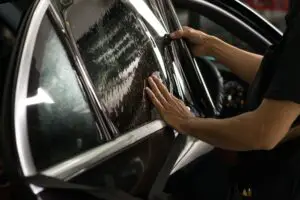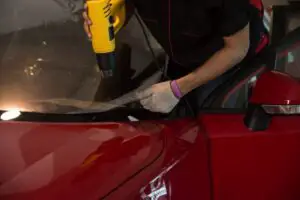For the convenience of other drivers, visibility of the owner, and to make law enforcement much easier, the state of Idaho has set various laws to make sure all of this happens.
Most of these laws are typically related to the darkness of the window tints.
Idaho window tint laws state that you cannot go lower than 20% and 35% for certain windows, while the windshield is limited to non-reflective tints, which must be on the top 6 inches of the screen itself.
The laws, in general, state the same for all car types. This goes for both the darkness of the tint and the reflection.
I will explain all of these laws in greater detail and any questions you may have, so make sure to read the whole article!
Table of Contents
- 1 How Much Tint Darkness Is Legal In Idaho?
- 2 Window Tint Reflection And Tint Colors
- 3 Medical Exemption Of Window Tint Laws In Idaho
- 4 Get A Certified Sticker From The Company
- 5 Other Window Tint Law Rules And Regulations In Idaho
- 6 Cost Of Car Window Tint In Idaho
- 7 Frequently Asked Questions
- 8 Conclusion
How Much Tint Darkness Is Legal In Idaho?

20% and 35% VLT seem to be the main numbers popping up when talking about the level of darkness in window tints in the state of Idaho.
VLT itself measures how much light goes in through the windows, where the lower the VLT, the higher the darkness.
Tint Darkness Limit For SUVs And Vans
Starting with tint laws set for sports utility vehicles and vans, owners of these vehicles are required to use non-reflective tints.
These tints must be limited to the first 6 inches of the windshield; otherwise, it goes against the rules.
Moving on to the front seat side windows, these have to be at the minimum of 35% VLT.
The back seat side windows can go a little darker, so they should allow at least 20% of light to pass through them.
The rear window switched back to the requirements of the front side windows, requiring at least 35% VLT. As I will show you, these rules extend further to sedans.
Tint Darkness Limit For Sedans
The tint laws for sedans follow the same rules and requirements as the SUVs and vans, so I will go over them on a window-by-window basis to explain them in depth.
1. Front Windshield
The windshield must not employ reflective tints at all.
Any tints applied to the windshield must be above the manufacturers AS 1 line or limited to the top 6 inches of the windshield itself.
2. Front Seat Side Windows
The front-seat side windows have to allow 35% of light to enter the vehicle at all times. This translates to 35% VLT at minimum.
3. Rear Window
The rear windows adopt the same rules as the front seat side windows and only have a reduced requirement of 20% VLT.
4. Back Seat Side Windows
This is then immediately bumped back up to the original 35% requirement in the case of the back seat side windows.
Window Tint Reflection And Tint Colors
- For the case of all vehicles, sedans, sports utility vehicles, and vans, the rules are generally the same.
- The front-seat side windows are not allowed to exceed a reflective strength of 35%.
- This is the same case for the back seat side windows, which cannot be more than 35% reflective.
- The state of Idaho has not banned color tints, meaning you can use whatever colors you want for your tinting needs.
Medical Exemption Of Window Tint Laws In Idaho

In the case of some states, the rules are set in stone, and no one can break them.
This offers little to no Leigh way for people who physically cannot abide by the rules and regulations.
This is a genuine concern for many people in certain states, especially when it comes to window tinting laws; however, the people of Idaho will not have to deal with these difficulties as the state allows medical exemptions for such people, allowing them to use special tints which include 75% on windshields and 2-% on other windows which is a generous amount.
Many people like those suffering from skin cancer cannot be in the sun for too long due to the UV light, which translates to inside the car as well, which is why being able to use darker tints will help out a lot.
If you believe you are medically exempt, you should have a doctor’s note or an official document at the ready-to-show law enforcement.
Get A Certified Sticker From The Company
The level of convenience given to the people is only heightened by the fact that the people are not required to show any form of certifications or stickers to the police.
This extends to manufacturers of the films as well; who do not have to certify that the film they are selling is legal and meets the standards in the state.
This makes it much easier to manage documents and avoid putting stickers on your car, ruining its aesthetic.
Other Window Tint Law Rules And Regulations In Idaho
Here are a few other rules and regulations that you should know if you are planning to tint your vehicle in Idaho.
- If your back window is tinted, you must have dual side mirrors.
- There is a light transmission tolerance of 3% in Idaho, allowing you to go 3% below the actual required value. It is highly recommended that you try and achieve the actual value as this 3% is merely a buffer in case of any mistakes.
- You are not required to have any stickers on your car to show the tinting is legal.
- You do not need any form of certification regarding the window tints.
Cost Of Car Window Tint In Idaho
There are different aspects of the cost.
For example, in some cases, you can tint all the windows of your car for a measly $400, while in other cases; it may cost you anything from $170 to $350 per window.
There are a lot of factors that can influence this pricing, such as the vehicle type, the number of windows it has, the place and manufacturer you are getting the films from, the quality of the films themselves, such as their durability and warranty associated with them.
High-quality films can easily cross the $300 threshold, and it will only go up if you want specific colors which are high in demand.
Overall, tinting your car windows in Idaho can range from decently cheap to quite expensive, so you should make a plan, assess which film you want, and operate according to your budget.
Frequently Asked Questions
Q1. Is 15% Tint Legal In Idaho?
Unless you are medically exempt, you cannot use 15% tints under any circumstances.
The lowest you can go is 20%, which is only for the rear window. All other windows must have 35% VLT with a buffer of 3%.
Q2. Are 5% Tints Legal In Idaho?
In the same case as above, 5% tints are not legal in Idaho as the state itself has determined the values of the amount of light required to enter the vehicle, which is far greater than what 5% tints allow.
Q3. Is Limo Tint Legal In Idaho?
Limo tints are very dark and block a lot of light out.
This conflicts with the rules set by the state, which is why it is fair to say that limo tints are not legal in Idaho, and you will get in trouble if you apply this tint to your vehicle.
Q4. Can I Get Pulled Over For Tint In Idaho?
If you are not following the tinting laws stated above, you can and will get pulled over by the police. This will cause them to give you an infraction.
Q5. How Much Is A Tint Ticket In Idaho?
Along with an infraction, you will be charged a $67 if you are caught with an illegal tint. This fine can also extend to the manufacturer that gave you the tint in the first place.
Conclusion
Idaho tint laws are very easy to understand and simple to follow.
They allow for a lot of freedom when it comes to tinting your vehicle and make it much easier for the people as not only do they not have to worry about stickers or certifications, but the people who suffer from certain conditions can apply for a medical exemption and get some relief.
The laws, in general, are straightforward.
So as long as you make sure that you follow the VLT requirements of every window, you should not have any problems with the authorities and law enforcement.

I am Tahir Azam, and I have been writing amazing articles for TaxiHack for as long as I can remember. I know everything that is to know when it comes to automobiles and is always on top of industry news and developments. While I am not an expert by any means, I pride myself on knowing the ins and outs of many different problems and, of course, their solutions. The articles on our website are some of the best and well-researched content that you will find, and I spend countless hours making sure this remains to be true. This is why I ask you to take your time out and read some of my articles, especially if you find a topic that resonates with you or is something you are looking into. This way, you will find the perfect mix of information and tips on your desired topic. Learn more about Tahir.



